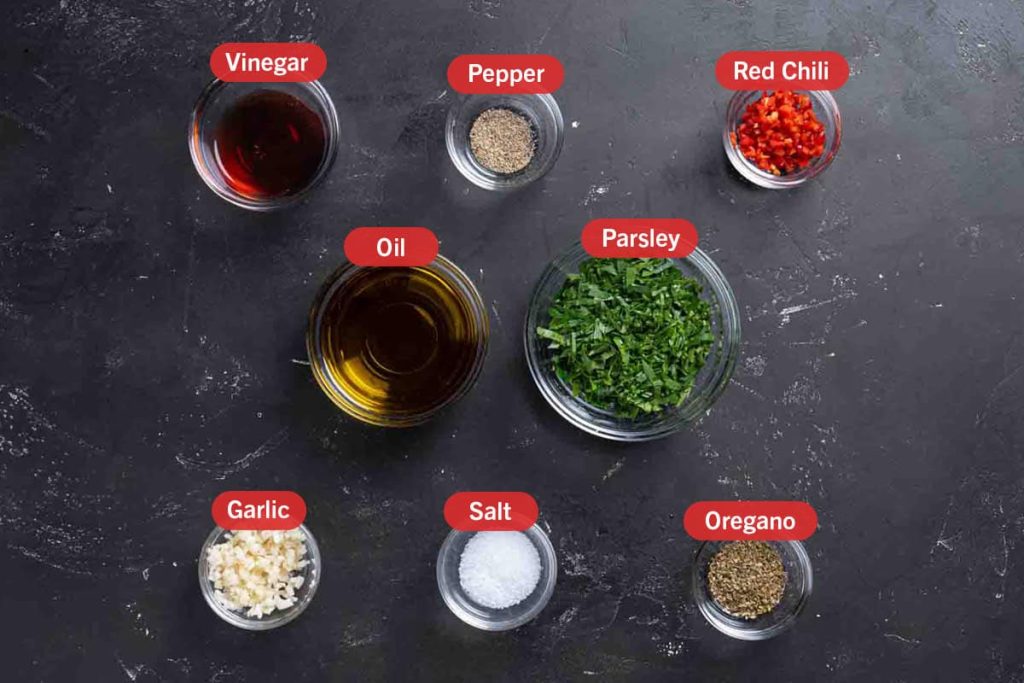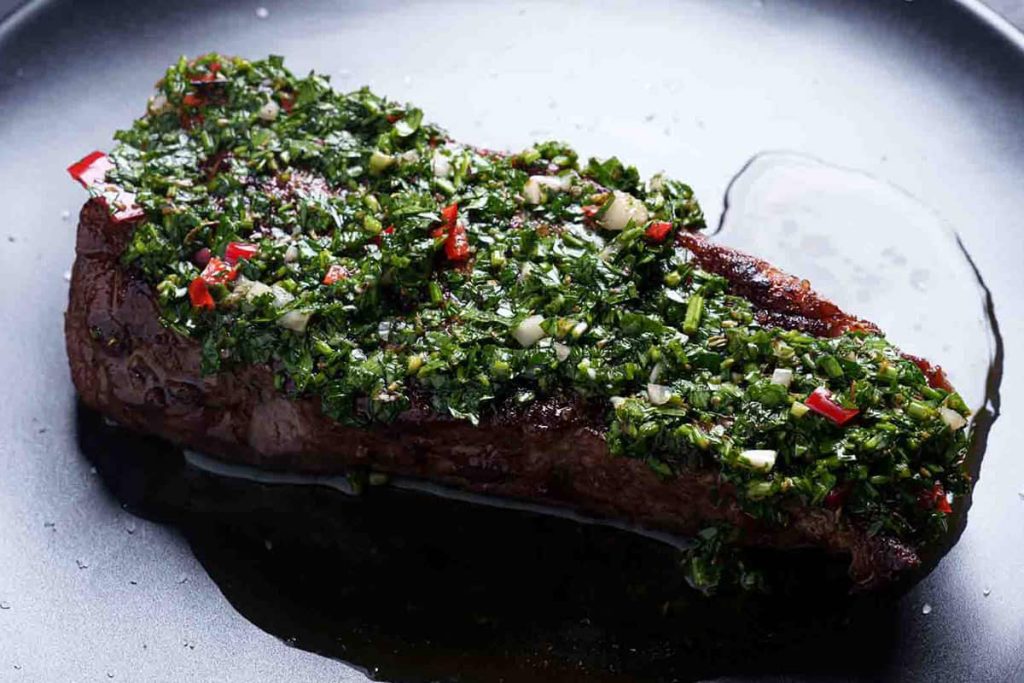Chimichurri is a beloved condiment from South America, especially popular in Uruguay and Argentina. This flavorful green sauce is traditionally served alongside grilled meats, particularly beef, but its versatility makes it ideal for chicken, fish, or vegetables as well.
Made with fresh herbs, garlic, vinegar, and olive oil, authentic chimichurri is both simple and deeply flavorful—a true reflection of the region’s grilling culture, known as asado.
1. Authentic Chimichurri Sauce Recipe
Yield: 8 Servings
Ingredients:
- 2 tablespoons red wine vinegar
- 1/2 cup parsley, finely chopped
- 3–4 cloves garlic, finely chopped or minced
- 2 small red chilies (or 1 deseeded chili, finely chopped, about 1 tablespoon)
- 3/4 teaspoon dried oregano
- 1 teaspoon coarse salt (level)
- 1/2 teaspoon black pepper (to taste)
- 1/2 cup olive oil

Instructions:
Step 1: Prepare the herbs and aromatics
Start by finely chopping the parsley and garlic. Traditional chimichurri is rustic, so you want the ingredients finely chopped—not blended. Use a sharp knife and take your time to achieve a fine yet textured consistency.
Step 2: Add the chili and seasonings
Finely chop the red chili and add it to the bowl. Adjust the amount based on your preferred heat level. Then, sprinkle in the dried oregano, salt, and pepper. These ingredients build the sauce’s robust base flavor.
Step 3: Mix with vinegar
Pour in the red wine vinegar and stir to combine. Vinegar adds tanginess and balances the richness of the olive oil. Let the vinegar soak into the herbs for a minute or two before adding the oil—it helps intensify the aroma.
Step 4: Add the olive oil
Slowly drizzle in the olive oil while stirring constantly. This step helps the oil emulsify with the vinegar, creating a silky yet slightly chunky texture. The oil carries all the flavors of the herbs and garlic, resulting in a smooth, aromatic sauce.
Step 5: Let it rest
Allow the chimichurri to rest at room temperature for at least 15–30 minutes before serving. This resting time lets the flavors meld beautifully. For an even more intense flavor, refrigerate the sauce for a few hours or overnight and bring it to room temperature before serving.
Step 6: Serve and enjoy
Serve your freshly made chimichurri as a topping or dipping sauce for grilled meats, roasted vegetables, or even as a marinade. Traditionally, it’s spooned over Argentine-style steak (asado), but it’s equally delicious with grilled chicken, shrimp, pork chops, or even drizzled over crusty bread.
2. Tips for Perfect Chimichurri Sauce
Use fresh parsley:
Fresh, flat-leaf parsley gives chimichurri its signature bright green color and herbal freshness. Avoid using curly parsley, as it has a milder flavor.
Chop, don’t blend:
Authentic chimichurri is always hand-chopped. Blending can turn the herbs into a purée, altering the texture and flavor.
Balance the acidity:
Red wine vinegar is classic, but you can adjust the acidity with a splash more or less depending on taste. Some versions even include a hint of lemon juice.
Let it rest:
Resting time is crucial. The longer chimichurri sits, the more the flavors meld. Ideally, prepare it at least 30 minutes before serving.
Experiment with heat:
Traditional chimichurri isn’t overly spicy, but you can increase or reduce the chili based on your preference. For milder flavor, remove the seeds from the chili before chopping.
Quality olive oil matters:
Use a good-quality extra virgin olive oil. Its rich, fruity flavor makes a huge difference in the final taste.
Store properly:
Keep leftover chimichurri in a glass jar or airtight container in the refrigerator. The flavors continue to develop over time, making it even better after a day.
3. Frequently Asked Questions
Q1: What is Chimichurri?
Chimichurri is a traditional herb and garlic sauce originating from Uruguay and Argentina. It’s typically made with parsley, garlic, vinegar, olive oil, and seasonings. It’s served as a condiment for grilled meats or used as a marinade in South American cooking.
Q2: What does Chimichurri Sauce taste like?
Chimichurri has a bright, tangy, and savory flavor profile. The parsley adds freshness, the garlic brings a sharp bite, and the red wine vinegar gives it a tangy kick. The olive oil smooths it all out, creating a balanced sauce that’s both fresh and bold.
Q3: How to customize Chimichurri flavors?
You can easily tweak the flavor to your liking. For example:
- Add cilantro for a more herbal twist.
- Include lemon zest or juice for extra brightness.
- Add a pinch of smoked paprika or crushed red pepper flakes for smokiness or heat.
- Mix in a little shallot or red onion for more depth.
Q4: How to store Chimichurri Sauce?
Store your chimichurri in an airtight glass jar in the refrigerator for up to 7 days. To prevent oxidation, make sure the sauce is fully covered in olive oil before sealing. You can also freeze chimichurri in ice cube trays for up to 3 months—just thaw as needed.
Q5: What are the best dishes to pair with Chimichurri?
Chimichurri is traditionally paired with grilled steak, especially Argentine asado. However, it also tastes incredible with chicken, shrimp, pork chops, lamb, or even grilled vegetables and roasted potatoes. You can also use it as a marinade or drizzle it over sandwiches and salads for extra zest.

4. Nutrition Information
| Nutrient | Amount (per serving) |
|---|---|
| Calories | 120 kcal |
| Total Fat | 13 g |
| Saturated Fat | 2 g |
| Cholesterol | 0 mg |
| Sodium | 300 mg |
| Total Carbohydrates | 1 g |
| Dietary Fiber | 0.5 g |
| Sugars | 0.2 g |
| Protein | 0.2 g |
| Vitamin A | 5% |
| Vitamin C | 7% |
| Iron | 2% |
| Calcium | 1% |
Conclusion
Authentic chimichurri sauce is more than just a condiment—it’s the heart of South American grilling tradition. Simple, fresh, and vibrant, it transforms any dish into a celebration of bold, natural flavors.
Whether you’re drizzling it over juicy steak, spooning it onto grilled shrimp, or mixing it into roasted vegetables, chimichurri brings the perfect balance of tang, spice, and herbaceous goodness.

